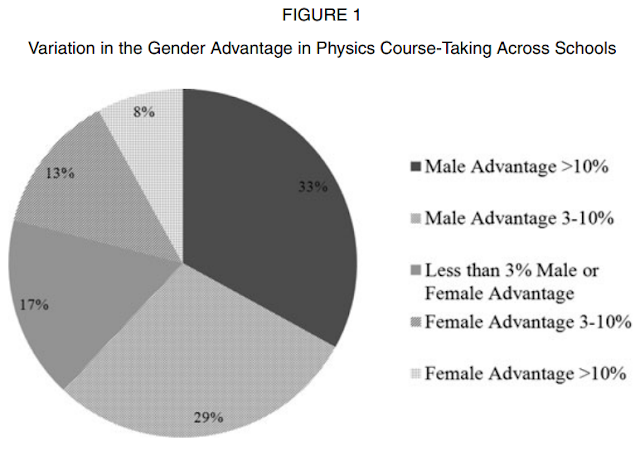Girls and Physics
Statistics informs. The usefulness of the information depends however on the analysis. Oftentimes, important trends may be buried under an aggregate. For example, a gender gap clearly exists in the fields of science and engineering in the United States. Data compiled by the National Science Foundation (excerpts are shown in a previous article in this blog) show that the percentage of females in these fields is lower than the percentage of females in the general population. By examining the data more closely, additional and more specific trends can be discovered as illustrated in "Not Lack of Ability but More Choice: Individual and Gender Differences in Choice of Careers in Science, Technology, Engineering, and Mathematics" in which the authors concluded:
The above trend is discovered by looking further and deeper. In this case, an explanation is provided for the existing gender gap in science and engineering. "The Gender Gap in High School Physics: Considering the Context of Local Communities", published in the Social Science Quarterly journal, looks at the statistics from a community perspective. Going beyond the aggregate, this paper examines the enrollment in physics courses in high schools. The results show that although taken as a whole, more United States high school male students take physics, in terms of individual schools, however, there are schools where females outnumber males in physics classrooms. In fact, the number of schools where there are more girls enrolled in physics is similar to the number of schools where boys outnumber girls:
Taking this analysis one step deeper, the authors find that the schools where female students are as likely as male students to enroll in physics are in communities where there is significant participation of females in the STEM labor force. The authors conclude:
"Our study provides evidence that it is not lack of ability that causes females to pursue non-STEM careers, but rather the greater likelihood that females with high math ability also have high verbal ability and thus can consider a wider range of occupations than their male peers with high math ability, who are more likely to have moderate verbal ability."
The above trend is discovered by looking further and deeper. In this case, an explanation is provided for the existing gender gap in science and engineering. "The Gender Gap in High School Physics: Considering the Context of Local Communities", published in the Social Science Quarterly journal, looks at the statistics from a community perspective. Going beyond the aggregate, this paper examines the enrollment in physics courses in high schools. The results show that although taken as a whole, more United States high school male students take physics, in terms of individual schools, however, there are schools where females outnumber males in physics classrooms. In fact, the number of schools where there are more girls enrolled in physics is similar to the number of schools where boys outnumber girls:
 |
| Figure captured from "The Gender Gap in High School Physics: Considering the Context of Local Communities" |
Additionally, the analyses show that the degree of gender difference in physics course-taking varies in relation to the gendered context of the local community labor force. The male advantage in high school physics is significantly smaller or nonexistent in schools situated within communities where more women are employed in STEM professions. This association is net of a host of rigorous controls to capture potentially confounding effects, including women’s representation in professional fields across all specialties.
In a previous post in this blog, "Wonderwise: Motivate Young Girls to Develop an Interest in the Sciences", I wrote:
A blueprint is a drawing of something you desire to build. In life, children grow up browsing through various blueprints. These are the adults children encounter early in their lives. They are usually called "role models" but these people seem to serve a similar purpose as blueprints do. They are copies of what children may aspire to become when they grow up. Parents are, of course, are the most obvious role models for young children. Outside the home, when children begin their formal schooling, teachers take this role as well. As children grow older, they get introduced to other role models. Indeed, the choices become numerous with increasing exposure to other people. These various role models are in fact options that a child may choose to imitate. Children begin to dream of what they want to become in the future.The statistics upon closer examination does support the above hypothesis. Oftentimes, we look for solutions in education that aim to address challenges in a society. What if the challenges education faces are actually rooted in the problems society faces?
Comments
Post a Comment